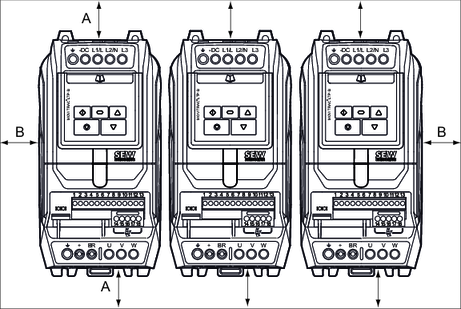IP20 housing: Installation and installation space
Inverters with degree of protection IP20 must be installed in a control cabinet. Observe the following requirements for this:
- The control cabinet must be made of a heat-conductive material unless it has forced air cooling.
- If you are using a control cabinet with ventilation openings, the openings must be located underneath and above the inverter. This allows good air circulation. The air must be supplied underneath the inverter and dissipated above it.
- If the inverter is operated in environments with particles of dirt such as dust, install a suitable particle filter on the ventilation openings and use forced air cooling. Clean and maintain the filter.
- In environments with a high level of humidity, salt or chemicals, use a suitable enclosed control cabinet (without ventilation openings).
- You can install inverters with degree of protection IP20 directly next to each other without any clearance.

|
Power of the inverter |
A in mm |
B in mm |
Air flow rate per inverter |
|---|---|---|---|
|
230 V: 0.75 to 2.2 kW (IP20) 400 V: 0.75 to 4 kW (IP20) 575 V: 0.75 to 5.5 kW (IP20) |
75 |
10 |
>18 m³/h |
|
230 V: 3 to 5.5 kW (IP20) 400 V: 5.5 to 11 kW (IP20) 575 V: 7.5 to 15 kW (IP20) |
100 |
10 |
>54 m³/h |
